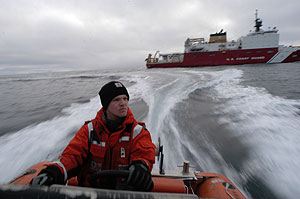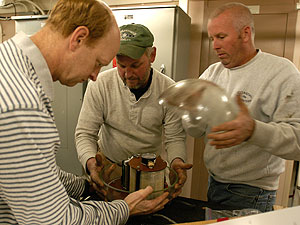|
|
 |
Daily Update
Calendar
Dispatch 10 - September 10, 2004
By C. A. Linder
Weather conditions: Mostly cloudy skies with intermittent snow
flurries, 15 kt winds, 2-3 ft seas, air temperature 34° F
View from the Waterline
This will surely be remembered as the longest day of the cruise for
the mooring crew and the ship's Marine Science Technicians and Boatswain's
Mates, who operate the Healy's deck equipment and small boats,
respectively. The day started just after breakfast with a small boat
briefing on the bridge. The Healy has two RHIBs (Rigid Hull
Inflatable Boats) to support science or rescue operations. As you
might recall from an earlier dispatch,
one of them recently received a complete engine replacement. Today
was the day to test out that new engine, while the other boat was
supporting the mooring crew. I jumped at the chance to ride in the
boat that was getting a test run.
Science
Crew Facts

Julia Linke has studied grizzly bear habitat in Alberta, Canada. She's looking forward to seeing some polar bears on the ice! |  |
My first task was to get into a "dry" survival suit.
That's a bit harder than you might think. The suit is essentially
a neoprene-lined ziplock bag... which is a great thing to have if
you fall into this freezing cold seawater, since it is designed to
keep you completely dry and warm. After a bit of wriggling, I finally
got the suit on and made my way to the ladder.
The boat was already bobbing on the waves below, about 20 feet down
the side of the ship. Once settled in, Boatswain's Mate Tom Hines
fired up the engine and we were zipping across the midnight blue water
of the Beaufort Sea. Unfortunately, the ride was a short one--the
new engine started sputtering and knocking, so Petty Offier Hines
decided to shut down the engine. That left us bobbing on the waves
while the other RHIB helped with the first mooring recovery of the
day. After that, they came to our rescue and towed
us back to the Healy. I was impressed by the way the
boat crews made the best of the unfortunate situation by turning it
into a rescue training exercise.
 |
 |
| Boatswain's Mate Philip Dawalt accelerates away from the Healy. |
Click to enlarge
|
When we got back to the Healy, I switched boats.
I wanted to see the mooring operation from
the boat crew's perspective. The first thing I noticed is how
different the Healy looks from the water. Onboard, the ship
feels extremely tall and narrow. From the water, you see just how
wide the ship is... No wonder it's so stable! The boat crew plays
an important role in safely recovering the moorings. Once John Kemp
has sent the release command and the mooring is floating on the surface,
the boat crew picks up a hook from the stern end of the Healy
and attaches it to the top float. Then, using a giant winch, the mooring
is reeled onboard. Without the boat crew's help, hooking that top
mooring would be a much more difficult operation.
During one of the mooring recoveries today, the lookouts on the bridge noticed that we had a rather unusual visitor...
Ryan Frazier recounts: "This morning I made
my quickest exit from bed yet, when the loudspeaker came through with
"Polar bear 600 yards off the port bow." I think about everyone, awake
or asleep, jumped at the announcement. Once we were on deck it was
a little bit difficult to see, as 600 yards is a long way, and only
its head was above water. All we saw was a little white dot, though
I could get a somewhat better view through the little binoculars I
have. While we watched it kept swimming along, heading off to who
knows where. It is amazing to even see it out here, as we are 35 miles
from Point Barrow, and even further from any ice. Hopefully we will
manage a better view of a polar bear before we finish, though it is
still spectacular to see one in the wild at any distance."
 |
 |
| From left, Jim Johnson, John Kemp, and Jim Ryder pop open the sphere that holds the data for the Beaufort Slope mooring #6. |
Click to enlarge
|
As I type this dispatch, the final Beaufort Slope mooring
is being secured on the fantail. Unfortunately, one of the three Acoustic
Recording Packages did not return to the surface. After waiting for
two hours for it to appear, it was surmised that the release had failed.
The other casualty was the Arctic winch, which was developed as a
means to measure the water column from the top float to the underice
surface. Judging from the evidence that was left on the top float, it appeared that the small Arctic winch float had gotten caught in an ice floe and ripped off the mooring. That still makes seven recoveries in one day, an incredible feat.
John Kemp & company will be sleeping well tonight. Overnight, Dan
Torres and Sarah Zimmermann will be calibrating the mooring instruments
so that we can see how accurate their measurements were.
Dan Torres explains:
"It is very gratifying to setup and deploy an oceanographic instrument
in the harshest of environments, come back a year later, recover that
instrument, and find it full of data. After we have the data back,
some of it has to be calibrated. This is mundane non-glamorous work
but it has to be done. We are mounting the CTDs that come off the
moorings onto the SBE911 CTD package. Then we do a series of casts
to calibrate the moored CTDs with the rosette CTD (which has very
accurate sensors)."
Tomorrow we will be moving farther west, to Barrow Canyon, a steep submarine valley located just off the nortwestern tip of Alaska.

|
Traducido al Español por
Mifaya |
Vista desde el Agua
Este dia será el día mas largo que recuerde el grupo de recuperación
de los moorings, os técnicos marinos y los compañeros de la tripulación
encargados del equipo de popa y de los botes. El dia empezó justo
tras el desayuno con un pequeño boletín informativo acerca de los
botes. El Healy tiene dos RHIBs (Embarcaciones semirigidas
inchables) para ayudar a los científicos o para usar en caso de rescate.
Como podrán recordar de comunicados anteriores,
uno de estos botes dispone de un nuevo motor. Hoy fue el dia para
poner a prueba el motor mientras el otro bote ayudaba en las tareas
de recuperación de los moorings. Aproveché para saltar al bote que
realizaba la prueba de motor.
Mi primera tarea fue meterme en uno de los trajes secos de supervivencia,
lo cual es algo más difícil de lo que parece. El traje es, esencialmente,
una bolsa de neopreno con cremallera…pero es algo esencial si te caes
en estas gélidas aguas, ya que esta diseñado para mantenerte seco
y calido. Tras un poco de forcejeo conseguí ponerme el traje y me
dirigí a la escalera donde el bote ya
estaba balanceándose sobre las olas, 20 pies por debajo de la altura
del barco. Una vez en el, arrancamos el motor del bote y nos desplazamos
en zig-zag sobre las azules aguas del Mar de Beaufort. Desgraciadamente
el viaje fue corto ya que el nuevo motor empezó a tener problemas
y el patrón decidió apagarlo, por lo que nos quedamos reposando sobre
las olas mientras el otro bote ayudaba con las tareas de recogida
de moorings. Después, vinieron a rescatarnos y llevarnos
de vuelta al Healy. Quede impresionado de cómo la tripulación
sacó el mejor partido de la desafortunada situación, aprovechando
para hacer un simulacro de rescate.
Cuando regresamos al Healy me cambié de bote para ver las
operaciones de recogida de moorings desde la perspectiva de la tripulación.
La primera cosa de la que me di cuenta es de lo diferente que se ve
el Healy desde el agua. Desde dentro, el barco parece extremadamente
alto y estrecho pero desde el agua te das cuenta de lo ancho que es…no
cabe ninguna duda de por que es tan estable! La tripulación juega
un importante papel en la seguridad del proceso de recuperación de
los moorings: una vez que el mooring esta flotando en la superficie,
la tripulación del bote lo ancla a la plataforma trasera del barco
y mediante una grúa lo suben a bordo. Sin la ayuda de la tripulación,
enganchar el mooring seria mucho más difícil. Hoy, durante una de
las recogidas, los vigilantes del puente notificaron que teníamos
un visitante inusual…
Ryan Frazier relata:
Esta mañana hice mi salida mas rápida de la cama cuando por los altavoces dijeron “Oso polar a 550 metros de la proa del barco”. Creo que todo el mundo, despierto o dormido saltó a raíz del anuncio. Una vez en cubierta, era un poco difícil verlo, ya que 550 metros es bastante lejos, y solo su cabeza estaba fuera del agua. Lo único que vimos fue un punto blanco aunque yo pude ver algo mas con mis prismáticos. Mientras le mirábamos, el seguía nadando hacia quien sabe donde. Fue increíble verlo aquí, a 35 millas de Punta Barrow, y mas lejos aun de cualquier hielo. Espero que veamos algo mejor un oso polar antes de terminar aunque sigue siendo espectacular ver alguno salvaje a cualquier distancia.”
Mientras tecleo este comunicado, el ultimo mooring de la colina subterránea de Beaufort esta siendo asegurado a popa. Desafortunadamente, uno de los tres equipos de grabación acústica no volvió a la superficie. Después de esperar a que saliese dos horas, se acepto que la liberación había fallado. La otra victima fue la polea Ártica, diseñada para calcular el espesor de la columna de agua desde la línea de flotación hasta la capa inferior del hielo. Aun así, son siete recuperaciones en el dia de hoy, todo un merito. John Kemp y compañía dormirán bien esta noche mientras que Sarah Zimmermann y Dan Torres calibran los moorings para ver cuan precisas han sido las medidas de los moorings.
Dan Torres explica:
“Es muy gratificante depositar un instrumento oceanográfico a merced del medio ambiente, regresar un año mas tarde y recuperar el instrumento lleno de datos. Una vez que tenemos los datos, algunos deben ser calibrados. Este trabajo es un trabajo poco glamuroso, pero tiene que hacerse. Estamos montando los CTDs en la roseta para comparar, mediante una serie de pruebas, cuan de precisos han sido los moorings.”
Mañana nos dirigiremos hacia el oeste, al cañón de Barrow, un empinado valle submarino localizado en la zona noroeste de la costa de Alaska.
 Previous
Dispatch
Next Dispatch Previous
Dispatch
Next Dispatch

Back to Calendar
|
|




